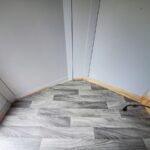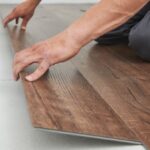Vinyl plank flooring has become increasingly popular due to its durability, affordability, and versatility. Whether you’re a DIY enthusiast or considering professional installation, understanding how vinyl plank flooring should be laid is crucial for achieving the best results. In this comprehensive guide, we’ll explore various layout options, provide a step-by-step installation guide, highlight common mistakes to avoid, and share best practices for a professional finish.
Table of Contents
Understanding Vinyl Plank Flooring Layout Options
Before diving into the installation process, it’s essential to consider the various layout options available for vinyl plank flooring. The layout you choose can significantly impact the overall look and feel of your space.
Straight Layout
The straight layout is the most common and straightforward option for vinyl plank flooring. In this pattern, planks are laid parallel to each other and perpendicular to the longest wall in the room. This layout creates a clean, uniform appearance and can make small spaces appear larger.
Diagonal Layout
A diagonal layout involves installing planks at a 45-degree angle to the walls. This pattern can add visual interest and make a room appear more spacious. However, it requires more precise cutting and may result in more waste material.
Herringbone Pattern
The herringbone pattern creates a sophisticated, zigzag effect by laying planks at a 45-degree angle to each other. This layout adds a touch of elegance and can make a bold statement in any room. It’s more complex to install and may require professional expertise.
| Layout Option | Pros | Cons |
|---|---|---|
| Straight | Easy to install, minimizes waste, makes rooms appear larger | Can look plain in large spaces |
| Diagonal | Adds visual interest, makes rooms appear wider | More difficult to install, increased waste |
| Herringbone | Elegant appearance, creates a focal point | Complex installation, higher cost, more waste |
Choosing the Best Direction for Vinyl Plank Flooring
When deciding on the best direction for your vinyl plank flooring, consider the following factors:
- Room shape and size
- Natural light sources
- Traffic flow
- Architectural features
Generally, it’s recommended to install vinyl planks parallel to the longest wall or in the same direction as the main light source. This approach can create a sense of continuity and make the room appear larger.
Step-by-Step Installation Guide
Now that you’ve chosen your layout, let’s dive into the installation process. Whether you’re tackling a DIY vinyl installation or following along with a professional, understanding these steps is crucial for a successful project.
Preparation
- Acclimate the flooring: Allow the vinyl planks to adjust to room temperature for at least 48 hours before installation.
- Prepare the subfloor: Ensure the subfloor is clean, dry, and level. Repair any damaged areas and fill in gaps or cracks.
- Remove baseboards and trim: This will allow for expansion gaps and a cleaner finish.
- Measure and plan: Calculate the room’s square footage and determine the starting point for your layout.
Installation Process
- Start in a corner: Begin laying planks in the corner farthest from the door, working your way out.
- Maintain expansion gaps: Leave a 1/4 inch gap around the perimeter of the room to allow for expansion and contraction.
- Stagger end joints: Ensure end joints are at least 6 inches apart for a more natural look and increased stability.
- Cut planks as needed: Use a utility knife or vinyl cutter to trim planks to fit around obstacles or at room edges.
- Click and lock: Most vinyl planks have a click-lock system. Angle the tongue into the groove and press down to secure.
- Use a tapping block: Gently tap planks together to ensure a tight fit, being careful not to damage the locking mechanism.
- Install the last row: You may need to cut the final row lengthwise to fit. Remember to maintain the expansion gap.
Finishing Touches
- Install transition strips: Use appropriate transition strips between different flooring types or in doorways.
- Reinstall baseboards and trim: Replace baseboards and trim to cover expansion gaps and complete the look.
- Caulk if necessary: Apply a small bead of caulk where the baseboards meet the floor for a polished finish.
| Tool | Purpose |
|---|---|
| Utility knife or vinyl cutter | Cutting planks to size |
| Tapping block | Securing planks together without damaging edges |
| Spacers | Maintaining consistent expansion gaps |
| Measuring tape and square | Ensuring accurate measurements and cuts |
| Rubber mallet | Gently tapping planks into place |
Mistakes to Avoid When Laying Vinyl Plank Flooring
Even experienced DIYers can make mistakes when installing vinyl plank flooring. Here are some common pitfalls to avoid:
Inadequate Subfloor Preparation
One of the most critical steps in vinyl plank installation is proper subfloor preparation. Failing to address issues like unevenness, moisture, or debris can lead to problems down the line. Always take the time to thoroughly clean, level, and dry the subfloor before installation.
Ignoring Acclimation
Skipping the acclimation process can result in expansion or contraction issues after installation. Always allow vinyl planks to adjust to room temperature and humidity for at least 48 hours before installation.
Improper Spacing
Neglecting to leave adequate expansion gaps around the perimeter of the room can lead to buckling or warping as the flooring expands and contracts with temperature changes. Maintain a consistent 1/4 inch gap around all walls and fixed objects.
Poor Pattern Planning
Failing to plan your layout can result in awkward cuts, uneven patterns, or a less aesthetically pleasing finish. Take the time to measure and plan your layout before starting installation.
Incorrect Cutting Techniques
Using improper cutting tools or techniques can damage planks or result in inaccurate cuts. Always use a sharp utility knife or vinyl cutter and make multiple passes for clean, precise cuts.
Best Practices for Professional Results
To achieve a professional-looking vinyl plank flooring installation, consider these best practices:
Invest in Quality Materials
Choose high-quality vinyl planks and underlayment to ensure durability and longevity. While it may be tempting to opt for cheaper options, investing in quality materials can save you money and hassle in the long run.
Use the Right Tools
Having the proper tools on hand can make a significant difference in the quality of your installation. Invest in a good utility knife, tapping block, and spacers to ensure precise cuts and proper spacing.
Pay Attention to Detail
Take your time and pay close attention to details like pattern alignment, end joint staggering, and maintaining consistent expansion gaps. These small details can make a big difference in the overall look of your flooring.
Consider Professional Installation
If you’re unsure about your DIY skills or have a complex layout, consider hiring a professional installer. Their expertise can ensure a flawless finish and may even save you money in the long run by avoiding costly mistakes.
Follow Manufacturer Guidelines
Always refer to the manufacturer’s installation instructions, as different brands may have specific requirements or recommendations for their products.
Expert Tips for Specific Challenges
Leveling Uneven Subfloors
If you encounter an uneven subfloor, use a self-leveling compound to create a smooth surface. This will prevent gaps or unevenness in your vinyl plank flooring.
Preventing Mold Under Planks
To prevent mold growth, ensure the subfloor is completely dry before installation. In areas prone to moisture, consider using a vapor barrier or moisture-resistant underlayment.
Installing Around Obstacles
When installing around obstacles like door frames or pipes, use a paper template to trace the shape onto the plank before cutting. This ensures a precise fit without damaging the plank.
Maintaining Your Vinyl Plank Flooring
To extend the lifespan of your vinyl plank flooring:
- Clean regularly with a damp mop and mild cleaner
- Use furniture pads to prevent scratches
- Avoid dragging heavy objects across the floor
- Place mats at entryways to reduce dirt and debris
Conclusion
Laying vinyl plank flooring can be a rewarding DIY project or a worthwhile investment in professional installation. By understanding the various layout options, following a step-by-step installation process, avoiding common mistakes, and implementing best practices, you can achieve beautiful, long-lasting results.
Remember to choose a layout that complements your space, prepare your subfloor thoroughly, and pay attention to details during installation. Whether you opt for a straight layout, diagonal pattern, or elegant herringbone design, proper installation techniques will ensure your vinyl plank flooring looks great and performs well for years to come.
If you’re unsure about tackling the project yourself, don’t hesitate to consult with a professional. At MattFlooring.com, we’re here to help you make informed decisions about your flooring needs and achieve the best possible results for your home or business.
Frequently Asked Questions
What is the best direction to lay vinyl plank flooring?
Generally, it’s recommended to install vinyl planks parallel to the longest wall or in the same direction as the main light source. This approach can create a sense of continuity and make the room appear larger.
How long should vinyl plank flooring acclimate before installation?
Vinyl plank flooring should acclimate to room temperature for at least 48 hours before installation. This allows the material to adjust to the temperature and humidity of the space, preventing expansion or contraction issues after installation.
Can I install vinyl plank flooring over existing flooring?
In many cases, vinyl plank flooring can be installed over existing flooring, such as hardwood or tile. However, the existing floor must be clean, dry, and level. Always consult the manufacturer’s guidelines and consider factors like floor height and subfloor condition before installing over existing flooring.

Chirag Sachdeva is a seasoned digital marketing expert with over 15 years of experience spanning digital strategy, content management, and SEO. Chirag is the founder of Digifly Technology, where he empowers businesses to grow through innovative digital solutions. With a deep understanding of content strategy and market trends.





